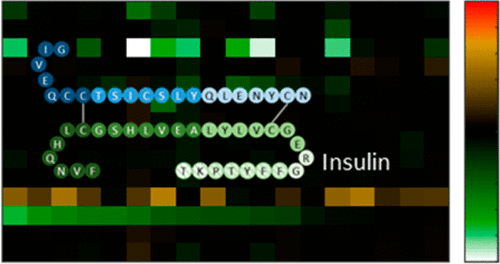Our official English website, www.x-mol.net, welcomes your
feedback! (Note: you will need to create a separate account there.)
Insulin Detection Using a Corona Phase Molecular Recognition Site on Single-Walled Carbon Nanotubes
ACS Sensors ( IF 8.2 ) Pub Date : 2018-02-07 00:00:00 , DOI: 10.1021/acssensors.7b00788 Gili Bisker , Naveed A. Bakh , Michael A. Lee , Jiyoung Ahn , Minkyung Park , Ellen B. O’Connell , Nicole M. Iverson 1 , Michael S. Strano
ACS Sensors ( IF 8.2 ) Pub Date : 2018-02-07 00:00:00 , DOI: 10.1021/acssensors.7b00788 Gili Bisker , Naveed A. Bakh , Michael A. Lee , Jiyoung Ahn , Minkyung Park , Ellen B. O’Connell , Nicole M. Iverson 1 , Michael S. Strano
Affiliation

|
Corona phase molecular recognition (CoPhMoRe) is a technique whereby an external, adsorbed phase around a colloidal nanoparticle is selected such that its molecular conformation or interaction recognizes a specific target analyte. In this work, we employ a high-throughput screening of a library of poly(ethylene glycol) (PEG)-conjugated lipids adsorbed onto near-infrared fluorescent single-walled carbon nanotubes to discover a corona phase selective for insulin. We find that a C16–PEG(2000 Da)–ceramide causes a 62% fluorescent intensity decrease of the (10,2) chirality nanotube in the presence of 20 μg/mL insulin. The insulin protein has no prior affinity toward the C16–PEG(2000 Da)–ceramide molecules in free solution, verified by isothermal titration calorimetry, and the interaction occurs only upon their adsorption onto the single-walled carbon nanotube scaffolds. Testing a panel of proteins originating from human blood as well as short 7 amino acid fragments of the insulin peptide rules out nonselective recognition mechanisms such as molecular weight, isoelectric point, and hydrophobicity-based detection. Interestingly, longer fragments of isolated α- and β-peptide chains of insulin are detected by the construct, albeit with lower affinity compared to that of the intact insulin protein, suggesting that the construct recognizes insulin in its native form and conformation. Finally, the insulin recognition and the quantification of its solution concentration were demonstrated both in buffer and in blood serum, showing that the CoPhMoRe construct works in this complex environment despite the presence of potential nonspecific adsorption. Our results further motivate the search for nonbiological synthetic recognition sites and open up a new path for continuous insulin monitoring in vivo with the hope of improving glycemic control in closed-loop artificial pancreas systems.
中文翻译:

使用单壁碳纳米管上的电晕相分子识别位点检测胰岛素。
电晕相分子识别(CoPhMoRe)是一种技术,通过该技术可以选择胶体纳米颗粒周围的外部吸附相,以使其分子构象或相互作用识别特定的目标分析物。在这项工作中,我们采用高通量筛选吸附在近红外荧光单壁碳纳米管上的聚乙二醇(PEG)共轭脂质库,以发现对胰岛素具有选择性的电晕相。我们发现,在存在20μg/ mL胰岛素的情况下,C 16 –PEG(2000 Da)–神经酰胺会使(10,2)手性纳米管的荧光强度降低62%。胰岛素蛋白对C 16没有亲和力-PEG(2000 Da)-神经酰胺分子在游离溶液中,通过等温滴定量热法验证,相互作用仅在其吸附到单壁碳纳米管支架上时发生。测试一组来自人血的蛋白质以及胰岛素肽的短7个氨基酸片段可以排除非选择性识别机制,例如分子量,等电点和基于疏水性的检测。有趣的是,尽管与完整的胰岛素蛋白相比亲和力低,但该构建体检测到了胰岛素的分离的α-和β-肽链的较长片段,这表明该构建体可以识别其天然形式和构象的胰岛素。最后,在缓冲液和血清中都证实了胰岛素的识别及其溶液浓度的定量,表明尽管存在潜在的非特异性吸附,CoPhMoRe构造仍可在这种复杂的环境中工作。我们的研究结果进一步激发了人们对非生物合成识别位点的探索,并为体内连续监测胰岛素开辟了一条新途径,希望能改善闭环人工胰腺系统中的血糖控制。
更新日期:2018-02-07
中文翻译:

使用单壁碳纳米管上的电晕相分子识别位点检测胰岛素。
电晕相分子识别(CoPhMoRe)是一种技术,通过该技术可以选择胶体纳米颗粒周围的外部吸附相,以使其分子构象或相互作用识别特定的目标分析物。在这项工作中,我们采用高通量筛选吸附在近红外荧光单壁碳纳米管上的聚乙二醇(PEG)共轭脂质库,以发现对胰岛素具有选择性的电晕相。我们发现,在存在20μg/ mL胰岛素的情况下,C 16 –PEG(2000 Da)–神经酰胺会使(10,2)手性纳米管的荧光强度降低62%。胰岛素蛋白对C 16没有亲和力-PEG(2000 Da)-神经酰胺分子在游离溶液中,通过等温滴定量热法验证,相互作用仅在其吸附到单壁碳纳米管支架上时发生。测试一组来自人血的蛋白质以及胰岛素肽的短7个氨基酸片段可以排除非选择性识别机制,例如分子量,等电点和基于疏水性的检测。有趣的是,尽管与完整的胰岛素蛋白相比亲和力低,但该构建体检测到了胰岛素的分离的α-和β-肽链的较长片段,这表明该构建体可以识别其天然形式和构象的胰岛素。最后,在缓冲液和血清中都证实了胰岛素的识别及其溶液浓度的定量,表明尽管存在潜在的非特异性吸附,CoPhMoRe构造仍可在这种复杂的环境中工作。我们的研究结果进一步激发了人们对非生物合成识别位点的探索,并为体内连续监测胰岛素开辟了一条新途径,希望能改善闭环人工胰腺系统中的血糖控制。











































 京公网安备 11010802027423号
京公网安备 11010802027423号